A lot has been written about Ecuador as a great retirement destination—and deservedly so. With mountains, beaches, and everything in between it is a land of an amazingly diverse range of comfortable climates and relaxed lifestyle opportunities. Perhaps overlooked in all of this is the fact that Ecuador is also a fantastic tourist destination.
With that in mind let’s take a look at some of the many things to see and do during a two-week visit to Ecuador exploring the cities of Quito and Cuenca in the Andes, and the beach resort of Salinas on the Pacific coast.
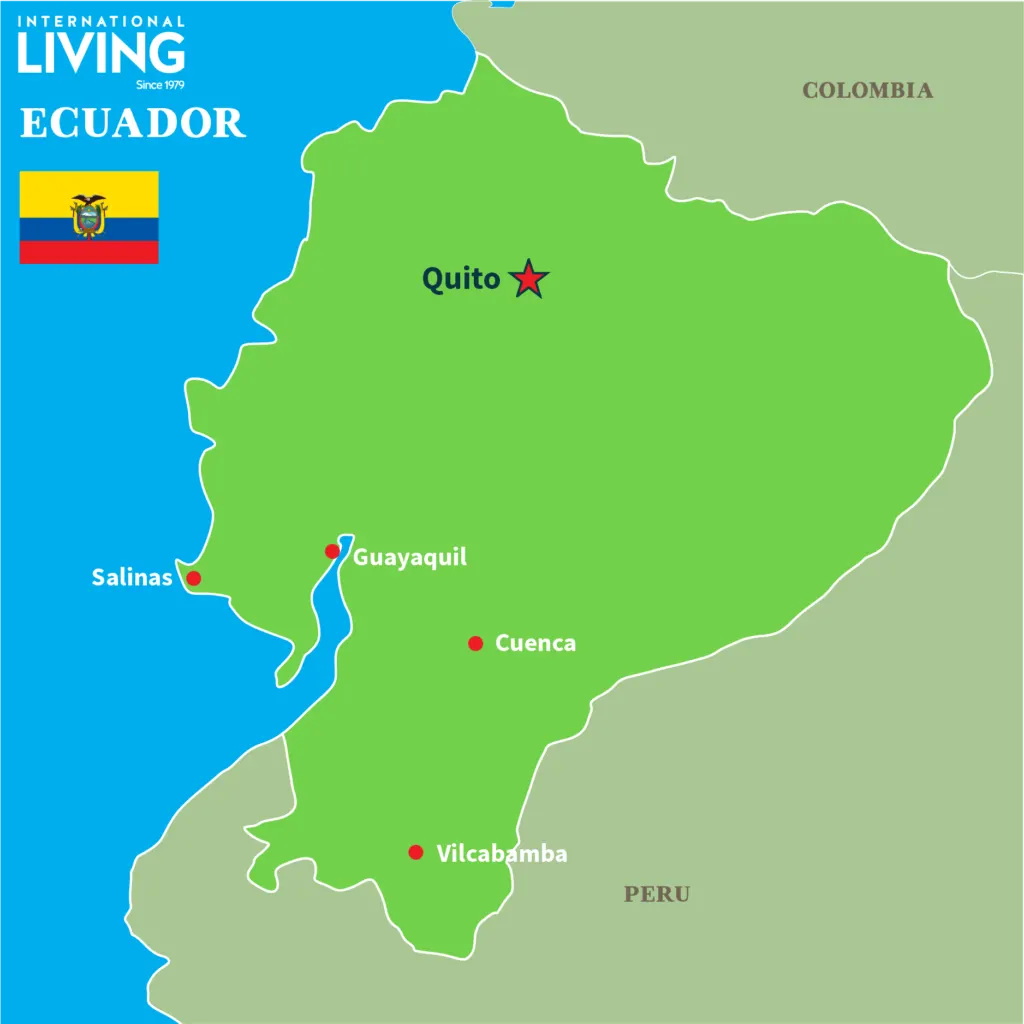
What to Pack?
For this unique vacation, you will need to pack for two different seasons; spring in the Andes, and summer on the beach. There’s some variation depending on the time of year, but on the coast in Salinas you can expect days to be somewhere in the 80’s F and nights in the low 70’s F. It hardly ever rains in Salinas, and very casual beach attire is the norm.
In the Andes, expect it to be 10 to 15 degrees cooler with some rain. Attire also tends to be a little more formal in Quito and Cuenca—for example, jeans are fine, but you rarely see men or women in shorts. In the Andes the saying is “there are three seasons in every day”, since it can be cool in the morning, quite warm in the afternoon sunshine, and then a quick bit of rain. Layers are the way to go, with a small backpack for when it is time to shed some clothing.
Quito, Capital City
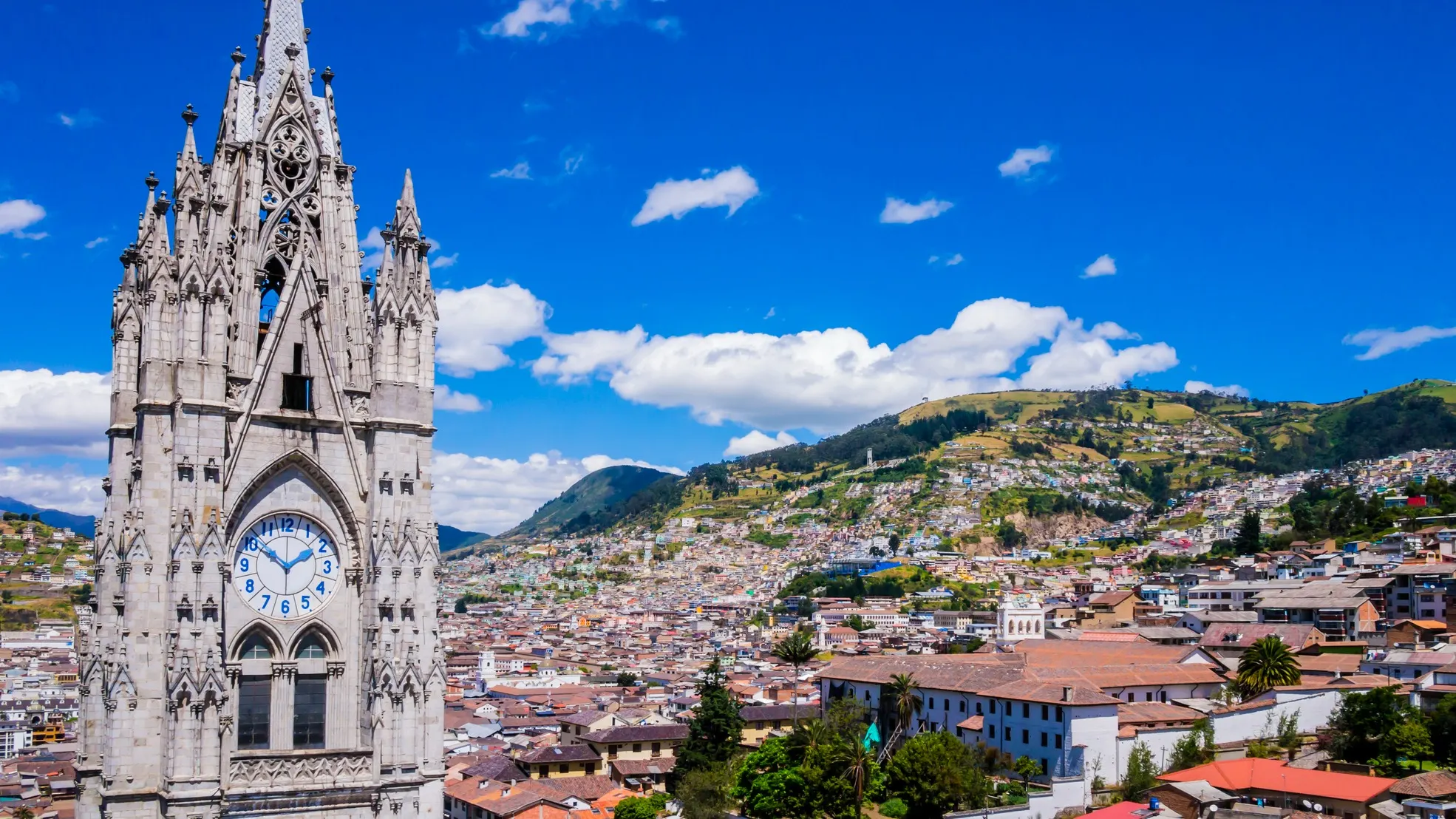
The airport is about 11 miles from Quito, and there are several ground transportation options. Public buses will take you downtown for $2, Aeroservicios has buses for $8, and taxis will take you directly to your hotel for a fixed rate of $28. You can also rent a car, but traffic and parking in Quito can be quite challenging and frankly with the cost of cabs and private drivers so low, it is probably not worth the hassle. Of course, some hotels in Quito and the surrounding areas also provide free shuttle services.
Where to Stay
There are great options to fit most any budget; for example a quick search I ran shows 546 available places for a party of two on the days I chose including a small B&B at $9 per night, a five-bedroom condo for $200, a luxury hotel in the center of the historic district for $410, and everything in between. Generally, you can find very nice accommodations in convenient locations that include breakfast and WiFi in the $50 to $100 per night range.
Some of my personal favorites in Quito:
Hotel Reina Isabela (https://hotelreinaisabel.com/en/) – Great location near Plaza Foch, comfortable modern rooms, included breakfast buffet, and with an airport shuttle service for less than $75 per night.
Hotel Rio Amazonas (https://www.hotelrioamazonas.com/en/) – In the same neighborhood and price range, another very comfortable place with friendly staff. Love their orange juice machine at breakfast—just drop fresh oranges in the chute.
Dann Carlton Quito (https://www.hotelesdann.com/dann-carlton-quito/?lang=en) – A little pricier in the $100/night, but well worth it if you feel like a little pampering. Located near Parque Carolina in a beautiful section of town, within walking distance to two malls and many great restaurants (including the one at the Hotel).
For the budget-minded, the Hotel Boutique Plaza Sucre (https://www.hotelplazasucre.com/en-us) in the historic district and the Hotel Suites Gonzalez Suarez (https://hotel-suites-gonzalez-suarez.quito-hotels-ec.com/en/) in the popular neighborhood of the same name will cost about $50 per night, breakfast included.
Your first day in the Andes, you should take things easy. Remember most of Quito is at about 9,000 feet altitude (2,700 meters), so you need to give your body time to adjust. Eat light meals, limit alcohol, and drink plenty of water to help acclimate. This would be a good day to explore the local neighborhood and talk to the staff if you would like to arrange for drivers during your stay.
Things to See and Do in Quito

Basílica del Voto Nacional, an imposing Roman Catholic cathedral. Although fairly “modern”, as its construction began in 1883, it is the largest neo-Gothic basilica in all of the Americas—at the time of its construction, it was the largest church in the world. You can tour the sanctuary for $1, and another $1 or two will let you climb to the top of one of the twin clock towers for a panoramic view of the city.
Plaza Grande, Independence Square. This is a lovely park in front of the Palacio de Carondelet, where the President of Ecuador lives and works. Surrounding the park are landmarks like the Metropolitan Cathedral, the Cultural Center, the Alberto Mena Caamaño Museum, and the Church of the Immaculate Conception.
The incredibly ornate Jesuit church (Iglesia de la Compañia de Jesús) where every square inch seems covered in gold, and the Saint Francis Plaza. The Plaza San Franciso includes the wonderfully restored brick square, a convent, and the church itself. There is also a national tourism shop on the corner, which offers free guides and information.
El Panecillo. This 45-meter tall aluminum statue of the Madonna stepping on a snake has been a must-see attraction since its inauguration in 1976. You can climb up to the pedestal on which she stands and continue all the way up to enjoy the view from the crown. Inside are exhibits showing photos of the design and construction and there are always vendors on the street outside with souvenirs and snacks.
Parque Carolina – in the heart of Quito is a wonderful multi-use park, reminiscent of Central Park in New York City. Biking and walking trails, a dog park, playgrounds, an insect and reptile house, skate parks, paddle-boats, and of course soccer fields, this park has it all. With the Quicentro and El Jardin Malls at either end and plenty of great shopping and restaurants surrounding it, this park is great place to spend a few hours or an entire day. Another more rustic option is the Parque Metropolitano Guanguiltagula where you will probably run into some wandering wild llamas.
Teleferico – On a clear day, a terrific place to see all of Quito in a glance is near the top of Mount Pichincha. Take a cab to the base station at a mere 9,000 feet and then the cable car up to the observation area at 12,000 feet (3,600 meters). Take in the views of the entire valley that is home to the city and suburbs. There are a few snack bars, souvenir stands, and even an oxygen bar if the altitude and view leave you a little breathless. Be sure to bring a jacket, as it can be quite a bit cooler at the summit, and weather can change quickly.
Mitad del Mundo – A great day-trip just an hour’s drive north of the city. Visit the monument that marks the equator (well, almost) and enjoy the many attractions, museums, and restaurants at the most-visited tourist site in Ecuador.
Where to Eat
When it comes to restaurants, you would have to work very hard to find a bad meal in Quito. As you might expect in a capital city, there are ethnic foods available from all over the world along with delicious and affordable Ecuadorian cuisine. American chains like McDonald’s, KFC, Burger King, Chili’s and more can be found, but our favorite local franchise is Menestras del Negro, which offers budget-friendly comida típica. You can enjoy a large filet of fish (or grilled pork, chicken, or beef), rice with lentils in a tasty thick sauce (that’s the menestras part), a small salad, and a large lemonade for $4.99 each.
More upscale restaurants like Segundo Muelle, Puerto Moro, and many others still will not set you back more than $20 to $30 per person. We’ve found that your hotel staff can make excellent recommendations for local eateries. You also can’t go wrong by visiting the Plaza Foch in the Mariscal Foch district, an area famous for its nightlife and variety of quality restaurants and bars. Be sure to sample locros de papas while you are in town, a rich bowl of potato soup.
Cuenca, Athens of Ecuador
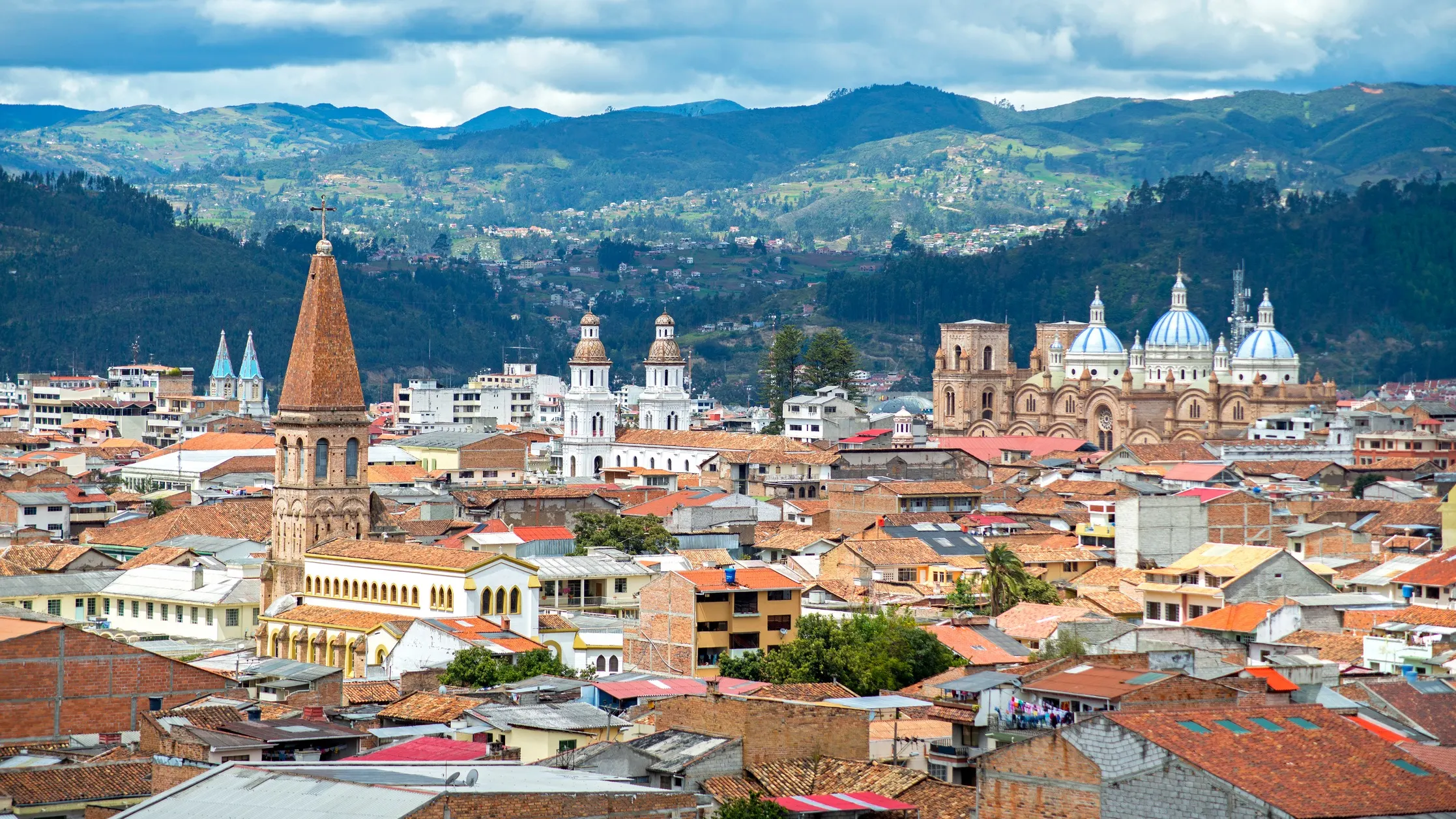
Located in the Andes at about 8,400 feet (2,560 meters) and with a modest-sized population of around 700,000, this colonial city earned its nickname “Athens of Ecuador” not just from the historic architecture found around the city center, but also because it is a nexus of education and culture.
Where to Stay
Most tourists prefer to stay in the El Centro neighborhood, where you can walk to most of the sites, or take a $2 to $5 cab ride around town. There are many pocket-friendly options from which to choose:
Cuenca Suites (https://www.cuencasuites.com/) near Parque San Sebastian, an easy walk to key attractions and restaurants. The rooms are located on several levels around an amazing courtyard; they're spacious, and come with high-speed internet, cable television, and a kitchenette. The owners speak English. From $40 a night for a double room.
Casa Ordonez (https://www.hotelcasaordonez.com/), a few blocks from Parque de Calderón. This renovated historic hacienda has high-speed internet, cable television, and serves a full breakfast each morning in the covered courtyard. Prices: From $45 per night for a double room in off season (breakfast included).
Casa Hibiscus Hotel (https://casahibiscushotel.com/) is easily one of the best deals in town. The restored colonial home is located five blocks from Parque de Calderón.
Rooms start at $40—the only drawback is that there are no televisions in the rooms, but there is high-speed internet.
There are hundreds of hotels in Cuenca, all at differing prices. For more options in the $40-and-up range, check out (to name a few): Casa San Rafael, Hotel Ines Maria, Hotel Presidente, and Hotel Inca Real.
Things to See and Do in Cuenca
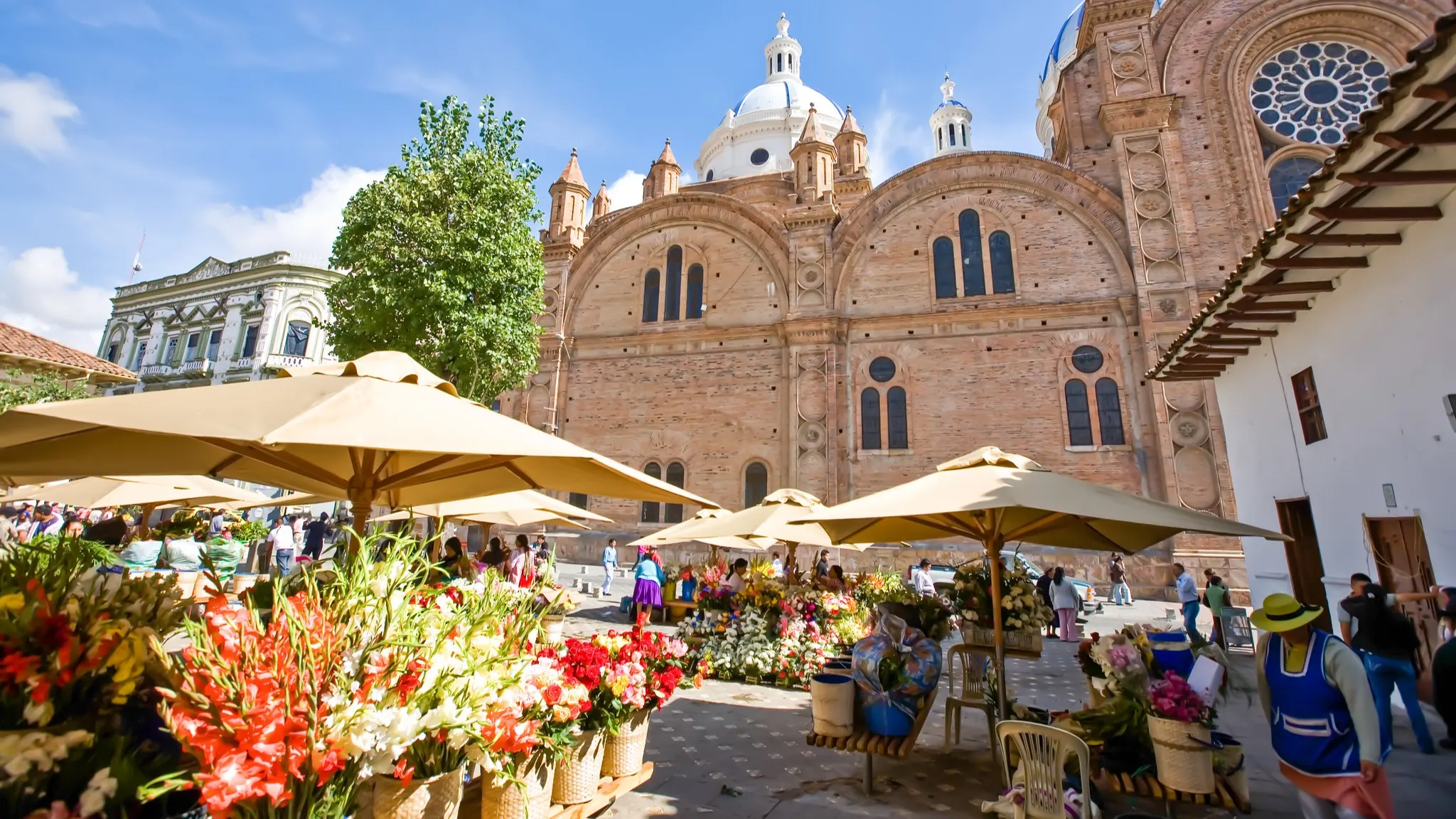
Parque de Calderon – Sandwiched between two other must-see attractions, the New Cathedral and Old Cathedral, this park is the natural place to start your time in Cuenca. Not to mention you can grab a chocolate chip mint or mango ice cream, relax, and people watch.
Pumapungo Museum and Arqueological Park - learn tribal history with great life-size displays and walk with llamas on the Inca ruins.
Remigio Crespo to go to outdoor cafes and stroll in this upscale neighborhood.
Take the tours so you don’t miss out on the history. The tour in the New Cathedral walks up to the top where the domes are with a spectacular view. A warning, though—it is a bit of a hard walk up the spiral staircase and no bathrooms, so plan ahead.
Take a double-decker bus tour of the 15th and 16th century architecture—which is why Cuenca is a UNESCO site.
Plenty of Markets – the Flower Market right next to the New Cathedral, the newly renovated San Francisco Market with the indigenous items for sale, the Rotary market for straw baskets, home decor, and unfinished furniture (as a bonus, shamans come once a week for cleansings) and of course it also has the big mercado with three levels of fruits, veggies, fish, meats, and more.
Where to Eat in Cuenca
Once again, you can’t go wrong here—or really anywhere in Ecuador—when it comes to food. Make sure you sample llapingachos (sort of a fried potato pancake, sometimes with a cheese and/or pork filling) and the fresh trucha (trout). IL’s Cuenca correspondent, Donna Stiteler, says that two of her favorites are Raymipampa which serves traditional Ecuadorian food and El Pedregal Azteca for its wide variety of Mexican food, such as burritos, tacos, fajitas, enchiladas, mole, poblano, etc. Donna also notes they are rumored to serve the best Margarita in town.
Salinas, Ecuador’s Most Popular Beach Resort
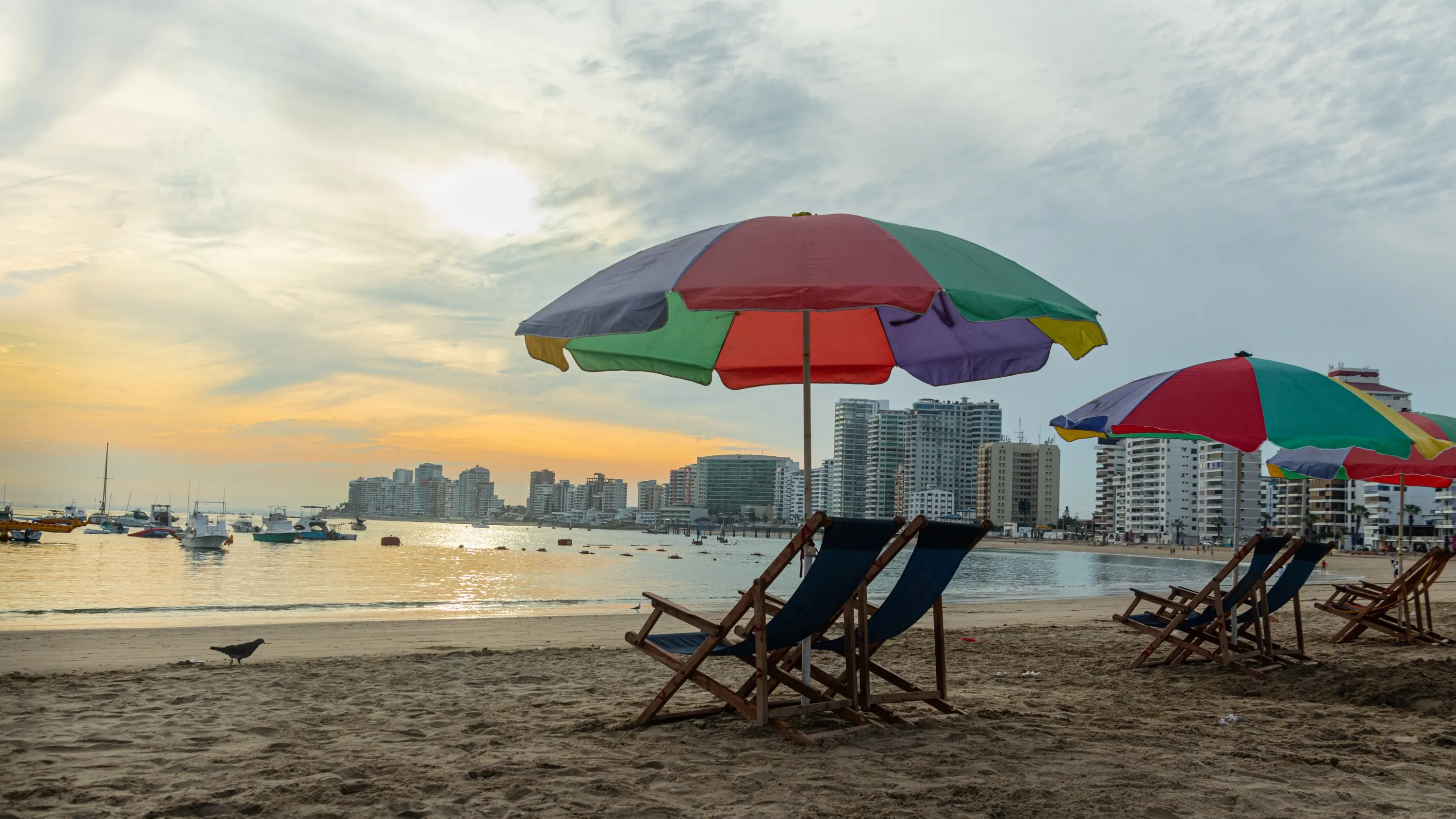
After a week and a half in the Andes, Salinas will seem like a different world—which in many ways, it is. The people of the coast and the people of the highlands have developed along different cultural paths, even with different historical pressures. Although Ecuador has a thousand miles of more of some of the most beautiful beaches in South America, Salinas’ unique location on a spear of land that juts out westward into the Pacific Ocean in an arid region with proximity to Guayaquil, the most populace city in Ecuador, have helped make the Santa Elena peninsula the number one beach resort.
With a resident population now approaching 200,000, the peninsula remains open for business year-round and positively rocks during holidays and high-season, when the number of tourists in town can reach 500,000.
Where to Stay in Salinas
Because it is a beach resort, it can be important to book ahead of time. Particularly if you plan to visit during high-season (November through May). Fortunately, there are many places to stay and at prices North American beach goers find a little surprising.
Hotel Casablanca Suites (https://www.hotelcasablancasalinas.com/en-us)- Located right on the malecon, this hotel is surprisingly affordable, with double rooms starting at $35 including Wi-Fi and breakfast. Great restaurant onsite as well.
Hotel Amira (https://www.hotel-amira.com/) – A little more expensive at $40 per person, the Amira is located in Chipipe, the more family-oriented beach adjacent to Salinas beach. With fewer restaurants and no bars, it is in a quieter location for a better night’s sleep.
Hotel Marvento (https://www.hotelmarvento.com) – With three locations all just a block off the beach, the Marvento chain is another great option for clean rooms, Wi-Fi, and breakfast for less than $50 per night for two.
Las Palmas Del Mar (https://www.laspalmasdelmar.com) – The perfect choice if you would like a quiet place on the beach away from the crowds. This small bed and breakfast run by expats will make you feel at home on the southern shore of the peninsula. You will enjoy peaceful sunsets but still be only a few minutes from all of the resort excitement. Rooms from $45 to $75 per night, with breakfast.
Barceló Salinas (https://www.barcelo.com/en-us/barcelo-hotels/hotels/ecuador/beach-salinas/barcelo-salinas/) – If luxury is your thing, Salinas has that as well. With a world class restaurant, sushi bar, two pools, swim-up bar, and more, the Barceló will make you feel like a king. Stays are all-inclusive, and start around $200 per night.
Things to See and Do in Salinas
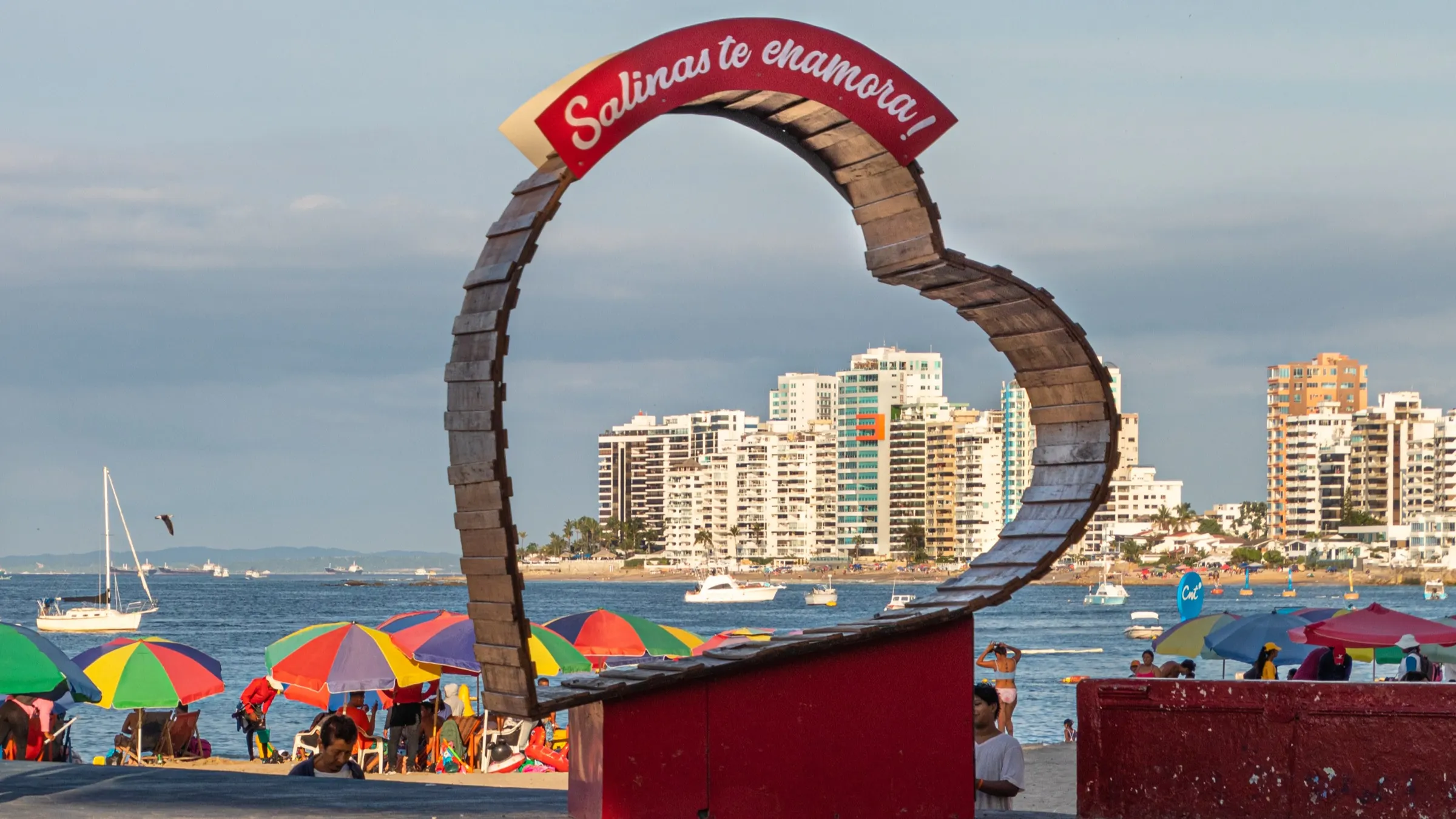
Let’s face it—it is all about the beach and the ocean in Salinas. Just a few of the options available to you:
Rent a Jet-Ski, kayak, or paddleboat. Vendors are everywhere, prices run between $10 to $20 per hour.
Charter a fishing trip. Excursions are available in a wide range of prices and options. Go for an hour or for the day. Equipment and bait provided on most trips, with sea bass, tuna, swordfish, marlin, and more feeding just off the coast.
What’s SUP? Learn the ins and outs of mastering Stand Up Paddleboard.
Scuba Diving – Learn to scuba dive or join an experienced group. Some organizers also offer spearfishing trips.
Just enjoy the Sun and Surf – You can rent a large square sunshade, chairs, and tables for just $8 a day. Relax and enjoy the beach, while roaming vendors bring you drinks, beer, cocktails, food, and whatever else you need.
Museo Amantes de Sumpa—If you simply must have some culture, take a $3 cab ride to the Museo Amantes de Sumpa. The coast of Ecuador was the home of some of the earliest inhabitants of the Americas, going back almost 10,000 years. Here you can see recreations of life on the coast, examples of plant life, and the eponymous centerpiece of the museum, the “Lovers of Sumpa”. This is the preserved grave of two young teenagers, buried while locked in an embrace.
What to Eat in Salinas
No surprises here—seafood. Thanks to the cold-water Humboldt Current that runs off the coast, scores of fish of all different species come to feed where warm meets cold. A local delicacy is ceviche, which is either shrimp or a mix of seafood soaked in a lime juice mixture and served at room temperature with thinly sliced onions, tomatoes, and spices. Shrimp dishes are everywhere, as well as corvina (sea bass), atún (tuna), linguado (flounder), varieties of shellfish, and so on.
Personal favorites are the empanadas de verde at Pedro’s Empanadas in Chipipe, and the filet-mignon at Luv N’ Oven on the malecon in Salinas. Two blocks back from the beach, El Valero has a dynamite almuerzo (lunch platter, with a soup, salad, rice, fried plantains, juice, and the seafood or meat of the day) for $3.50. Despite being a beach resort, you will find that most lunches are less than $6 per person, and two people can eat dinner for $20 or less.
Getting in, Getting Around, and Getting Home
For this trip, the best arrival option is Mariscal Sucre International Airport in the capital city of Quito. After spending three or four days there, the next stop is Cuenca, about 200 miles south of Quito as the crow—or rather, the condor—flies. It is possible to take a bus or car down the Pan American Highway, but although the scenery along this Valley of the Volcanoes is incredibly beautiful, it is a ten-hour drive and best enjoyed as a two-day trip, with a stop-over in Ambato. A better option may be to take the 45-minute shuttle flight from Quito airport to Mariscal Lamar Airport in Cuenca ($80 to $90 per person), which gives you the full three to four days to explore this fascinating city.
For your trip to the coast, a private van or driver can take you to Salinas in about 6 hours, travelling through the majestic Cajas National Park. The road tops 13,000 feet (4,000 meters) in several places, and you will quite likely see some llamas along the way. If you time it right and have your own driver, be sure and stop for a fresh trout lunch at one of the deportivas in the park. Remember that it is customary to treat your driver to his meal as well. Since lunches at most of these stops run about $4, it shouldn’t set you back too much.
After you enjoy all that Salinas has to offer, you have options on your return. If you purchased a round-trip to Quito you can fly back there from Guayaquil, again for about $80 to $90 per person. Or you could book a multi-city flight, so that you arrive in Quito and exit from José Joaquín de Olmedo International Airport in Guayaquil near the coast. This may save you money and time. Check out both options with your favorite trip planning website.
Final Thoughts
So there you have it, just a small taste of the things you can see and do in Ecuador. In our six years living and exploring the country, we have been amazed at how economical and easy it is to travel and find great accommodations. There is so much more that we did not touch on here, like hiking around Cotacachi, the colorful Otavalo markets, the scenic and adventure-sport town of Baños, boat trips down the tributaries of the Amazon, coastal trips to tour small fishing villages, and let’s not forget the Galápagos. All in all, Ecuador turns the old saying on its head: It’s a great place to visit, and you might just want to live there.
Related Articles
Move to Ecuador for Its Wealth of Charms
